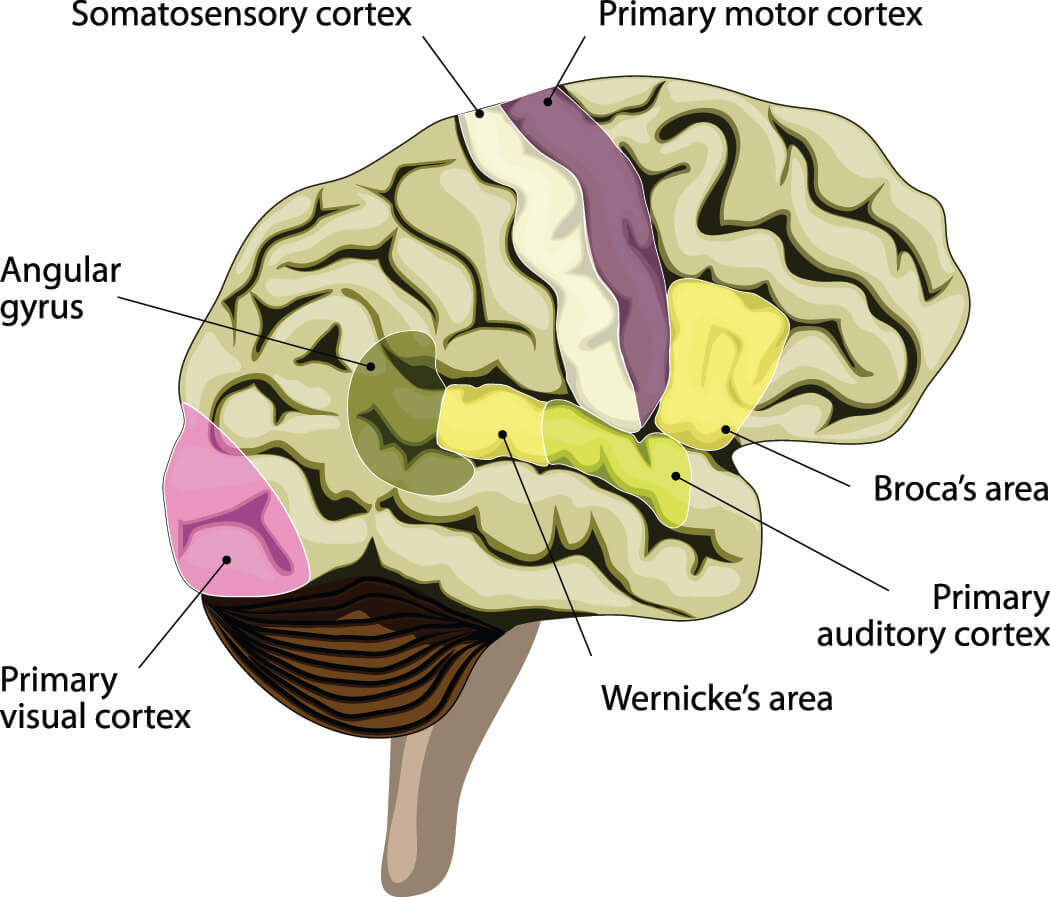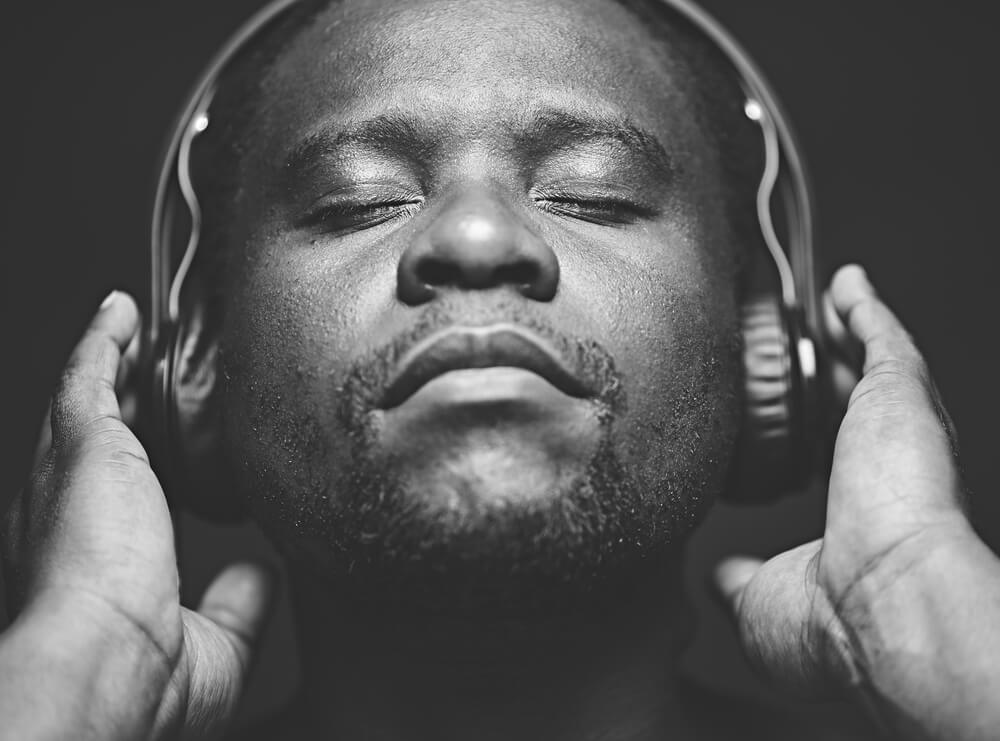Definition
Broca’s area is a part of the brain named after the French physician who first linked it to language processing. It is located in the frontal lobe of the dominant brain hemisphere – opposite to the dominant hand. First thought only to produce speech, Broca’s area is now known to assist our understanding of the spoken word, our gestures, our speech fluidity, and our interpretation of the actions of others.

Broca’s Area Function
The function of Broca’s area or Broca area is made clearer when we look at the effects of Broca aphasia; phasia is the Greek term for speech, and the insertion of the prefix a means the absence of speech. Another clue to this region of the brain’s function is the other name for Broca aphasia – expressive aphasia. When part or all of Broca’s area is damaged, through chronic inflammation, age-related degeneration, stroke, tumor, or trauma, for example, specific symptoms that change our ability to communicate and understand the communications of others can occur. Symptoms can be mild (dysphasia) to severe (aphasia). Sudden trauma usually causes immediate and severe symptoms; degenerative causes mean symptoms can develop over longer periods. Sometimes, the brain can transfer Broca’s area functions to other regions in the right conditions. More about this later.
Most right-handed people have a left-sided Broca’s area and vice versa. This part of the frontal lobe is very connected to other parts of the brain that include the rest of the frontal cortex, basal ganglia, cerebellum, and the opposite brain hemisphere. This means that damage to Broca’s area can produce a very broad range of symptoms.

Like most of the central nervous system, Broca’s area never produces an effect without assistance. We should always think of the workings of the brain as a chain reaction, where each specific set of neurons processes incoming information before sending it on in a slightly different form to the next group of cells. When we look at Broca’s area in this context, we can imagine it as a central cog in the complex machine that controls our brain’s language organization network.
The most active areas of the language organization network are found in the dominant hemisphere of the temporal lobe, but Broca’s area is a great example of how this network is spread throughout different parts of the brain. Broca’s area is located in the inferior (lower) posterior (back) section of the frontal lobe, quite close to the speech centers and the auditory canal. It houses specialized cell types grouped into two Brodmann areas – 44 and 45. Brodmann areas (BAs) are areas of specialized nervous tissue that have been mapped over the years to produce an alternative view of the brain. While our new knowledge is showing that these numbered regions are nowhere near as clearly outlined as in our anatomy textbooks, they do help us to navigate where certain processes take place. BA 44, for example, is a group of specialized cells located close to the mouth and tongue motor centers of the brain; they are strongly associated with language production and expressive language. However, on MRI imaging this area is also active when we listen to music and process grammar. This just goes to show that there is still a lot to be learned from the incredibly complex structure of the brain. BA 45 is crucial but not singularly responsible for verbal memory, verbal fluency, and word meaning.

Language organization in the brain is hardly a simple topic. Each pathway must interconnect to provide meaning, understanding, and efficient communication with other people and animals. We learn new words, categorize them first on a basic level, and then into further subcategories. We tie groups of words together to produce sentences and use memory to store separate words and their countless associations so we can form full sentences. We mix visual and verbal stimuli with olfactory information so we can see a rose, recognize it through shape, color, smell, and name, and store the word in our memories. If your first experience of a rose involved being badly scratched by a particularly evil thorn, your associations will differ from those who have more pleasant memories. Sometimes, specific words can make you feel physically sick, as with koumpounophobia. This strange phenomenon, at least partially, involves Broca’s area. If you are wondering what koumpounophobia is, have a quick read of this short article.
Language is loosely grouped into phonetics and phonology. Phonetics describes the study of the mechanisms that produce and transmit sounds made during speech. Phonology looks at how speech is interpreted in terms of syntax (grammar and sentence construction), semantics (meaning), and pragmatics (social use of language for communication purposes). Broca’s area is involved in all of these processes.
There has been a lot of research done concerning Broca’s area function but what we actually know is still very incomplete. Previously thought only to play a part in language production, we now know that Broca’s area is integral to our understanding of the spoken and written word. Other studies tell us that Broca’s area is linked to stuttering where it seems to be underactive. Gesturing to increase our chances of communicating a point is also linked to this small part of the brain (the fish was this big!). We shouldn’t be too surprised about this, as Broca’s area lies right next to the motor cortex.

Remembering earlier movement is also part of Broca’s area functions. An example could be retracing your steps (in your mind) to find your keys. Understanding that motor-memory function is also, in some way, regulated by Broca’s area has encouraged further studies. It is now accepted that this region is much more than part of the language processing network; however, we are still left in the dark about much this region of the brain is capable of.
That said, Broca’s area roles can be taken over by other parts of the brain if necessary. A right-handed patient with a left frontal brain tumor underwent surgery to remove the tumor and Broca’s area was also taken away. What is strange is that the patient was still able to speak after surgery. It has been suggested that the slow growth of the tumor gave the brain time to adjust and let other regions take over. Brain plasticity – or the ability of the brain to regenerate – is a hot topic. When the causes of brain degeneration are removed, the brain can recover. We see this in cases of stroke where some skills return quickly and others require a longer period as the brain slowly heals. Others never return.
A great number of studies have shown Broca’s region contributions in working memory, calculation, music processing, gesturing, imagination, observation, execution, imitation, and recognition as well as the language-processing aspects of phonology, semantics, syntax, speech perception, and speech production. We should also remember that Broca’s area is a link in a longer chain or a cog in a huge machine and never works alone.

Language Processing Areas
Broca’s area function in terms of speech is dependent on the functions of other structures. Broca’s area within the dominant frontal lobe is significantly connected to Wernicke’s area in the dominant temporal lobe. Wernicke’s area consists of three sections that respond to our own or someone else’s spoken words, process any type of sound, and contribute to speech production. Wernicke’s area is also associated with spoken or memorized sequences of sounds or syllables.
Another area important to language processing is the supramarginal gyrus – a part of the brain that is very well connected to all regions involved in speech and understanding, including Broca’s area. The supramarginal gyrus seems to play an important role in articulation. Other gyri (brain folds) – the angular gyrus and posterior cingulate gyrus – are crucial for our use of semantics. These gyri receive stimuli from the ears, eyes, and skin and allow us to put names to objects and feelings.

Broca’s and Wernicke’s areas are commonly agreed to be the brain’s centers for primary speech production, but damage to any speech-associated regions will probably cause speech disorders. For example, if the angular gyrus is damaged, it may be difficult to write, to perceive right from left, and – rather strangely – it may become impossible for someone to work out if a set of fingers belongs to them or a stranger. This group of symptoms related to angular gyrus damage is called Gerstmann syndrome.
Damage to Wernicke’s area can produce Wernicke’s aphasia (receptive aphasia). The person can speak fluently but uses the wrong words. He or she will know exactly what they are talking about; that isn’t the case with whoever is listening; it sounds like nonsense to them.
Broca’s area lesions cause halting speech without proper sentence structure and grammar. The group of associated symptoms is called Broca aphasia. Broca aphasia is described in more detail below. You can select the appropriate tabs in this university link for clear examples of the differences in speech patterns between Wernicke’s and Broca’s area damage.
Broca Aphasia
Broca aphasia is a frustrating speech and semantics disorder that is sometimes referred to as non-fluent or expressive aphasia. Individuals can only understand very short, simple sentences; their speech stops and starts time is needed to find the right word. Most of the time the person will only use three or four words per sentence.
The effects of Broca aphasia go beyond language. This area’s proximity to the motor cortex means right-sided weakness (in right-handed people) is also common. When oxygen and glucose supply to this part of the brain is limited – such as during a stroke – extensive areas of the frontal and temporal lobe can be affected. What areas are damaged decide the severity and range of symptoms.

A person with Broca aphasia will speak very simply. ‘Horse horse two field’ may replace ‘there are two horses in the field’. Note the repetition of the word horse to denote an additional numerical clue. This also shows a strong association between calculus and speech. Unlike Wernicke’s aphasia, a person suffering from Broca aphasia will nearly always be aware of the limitations of their way of communication. Both types can understand what is said by others, especially when simpler sentences are spoken slowly.
